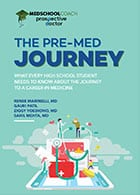
Table of Contents
Historically black colleges and universities (HBCUs) are educational institutions that historically enroll more students of African-American descent than students of other ancestries, particularly European.
There are 107 HBCUs for undergraduate studies in the US, but only 4 medical schools are classified as HBCUs. These are often referred to as HBMSs (historically black medical schools).
If you feel you’ll fit in better at an HBCU medical program, you have 4 to choose from in America — Howard, Meharry, Morehouse, and Charles R. Drew. But two more are coming soon — Morgan (MDCOM) and Xavier Ochsner of Louisiana (XOCOM).
Learn more below about each HBCU so you can figure out which historically black medical school best suits your needs and wants.
Deciding which medical school is right for you? Use MedSchoolExplorer to compare stats and info on US medical schools and determine what’s a good fit based on your metrics, goals, and needs.
The 4 Existing Historically Black Medical Schools (HBMSs)
Currently, there are 4 HBSMs. Let’s talk about tuition, student body size, acceptance rate, and more. Many colleges do not publish standardized statistics, so certain data is approximated and compiled from what is available.
All 4 of these HBSMs offer MD degrees for physicians studying allopathic medicine. No existing HBCU medical programs offer osteopathic medical degrees (for DO physicians), but Morgan State plans to start this program by the fall of 2024. Learn the difference between MD and DO programs.
1. Howard University College of Medicine
- Tuition and mandatory fees: $57,632
- Student body size: 436
In 1867, Howard University was established in Washington, D.C. By 1968, the Howard University College of Medicine was founded. The college is responsible for a sizable portion of Black physicians working today and throughout the past 150 years.
Below is the estimated racial breakdown of Howard’s student body:
- 74% Black or African-American
- 7% Hispanic, Latino, or Spanish origin
- 4% Asian
- 4% of two or more races
- 1% White
- 1% American Indian or Alaska Native
- 9% unknown or declined to answer
Read Next: Best Premed Schools
2. Meharry Medical College
- Tuition and fees: $63,688
- Student body size: over 900
Founded in 1976, Meharry Medical College is located in Nashville, Tennessee and is affiliated with the United Methodist Church. Meharry has a School of Medicine, a School of Dentistry, and a School of Graduate Studies and Research.
Below is the estimated racial breakdown of the Meharry Medical College student body:
- 87% Black or African-American
- 6% Asian
- 4% White
- 2% Hispanic, Latino, or Spanish origin
- 1% American Indian or Alaska Native
Read about how MedSchoolCoach partners with Meharry to support their medical students and prepare them for residency.
3. Morehouse School of Medicine
- Tuition and fees: $56,345
- Student body size: Over 700
Morehouse School of Medicine (MSM) was established in 1975 as part of Morehouse College (est. 1867), but MSM became independent in 1981. It is a prestigious medical degree program located in Atlanta, Georgia.
MSM received a #1 ranking in the country for its social mission. Factors considered include the proportion of graduates who:
- Practice primary care
- Work in health professional shortage areas
- Are underrepresented minorities
Below is the estimated racial breakdown of MSM’s student body:
- 80% Black or African-American
- 6% Asian
- 5% White
- 3% Hispanic or Latino
- 3% of two or more races
- 3% unknown or declined to answer
4. Charles R. Drew University of Medicine and Science
- Tuition and fees: $69,000
- Student body size: 28 in a joint program with UCLA, about 60 in the MD program independent of UCLA
In response to the Watts Riots in 1965, Charles R. Drew University of Medicine and Science (CDU) was established in Los Angeles County, California, in 1966, to increase Black physicians in the area.
Though most HBCUs are in the South, CDU is located on the West Coast. This university offers degrees in 3 colleges: Medicine, Science and Health, and Nursing.
Since 1978, Charles Drew University has partnered with UCLA’s David Geffen School of Medicine so that 28 CDU students will complete their first 2 years of medical school at UCLA and then finish their final 2 years of clinical work at CDU.
In 2023, CDU began a new Doctor of Medicine (MD) program separate from its joint program with UCLA. Once that first class of MD students graduates, CDU can attain full LCME accreditation.
Here are the most recent stats for CDU:
Below is the estimated racial breakdown of the CDU’s student body:
- 31% Black or African-American
- 16% Hispanic, Latino, or Spanish origin
- 16% of two or more races
- 15% Asian
- 8% White
- 14% unknown or declined to answer
Coming Soon: 2 More HBMSs
With the shortage of HBMSs in America, 2 more HBCUs are expanding into medical education. In the fall of 2024, Morgan State University plans to open a med school. Later, Xavier University plans to welcome its first class of medical students into a brand new HBMS, though the details are uncertain.
5. Maryland College of Osteopathic Medicine at Morgan State University
Morgan State University is an HBCU established in 1867 in Baltimore, Maryland. The new Maryland College of Osteopathic Medicine (MDCOM) is proposed to open to students by August 2024.
Morgan State was one of the first HBCUs after the Civil War. After the coronavirus pandemic and the societal shifts after George Floyd’s murder, the university sought to expand their mission to reduce health disparities and train diverse medical professionals through MDCOM.
This HBMS will be the first historically Black higher education institution to offer a degree in osteopathic medicine (DO).
Read Next: Best DO Schools
6. Xavier Ochsner College of Medicine at Xavier University of Louisiana
Xavier University of Louisiana (XULA) is the only Catholic HBCU. It was established in 1925 by St. Katharine Drexel, the first person born a U.S. citizen to be canonized. 80% of its attendees are Black or African-American.
Xavier University and Ochsner Health have signed an agreement to establish a new medical college, announced officially on April 29, 2024. They plan to open their medical school possibly by 2030, but exact opening dates have not been publicized.
The History of Black Medical Colleges
Racism runs deep within American culture. The troubling history of Black medical colleges, though, may have resulted from systemic racism with “good” intentions.
Abraham Flexner wrote in 1910, “[Black people need] good schools rather than many schools.” A majority of scholars and historians attribute this educator’s 1910 Flexner Report with limiting Black people’s access to medical education.
Commissioned by the Carnegie Foundation, the Flexner Report evaluated all medical schools in the country, calling for high standards of excellence in teaching and curriculum.
Flexner wrote, “Of the seven medical schools for [Black people] in the United States, five are at this moment in no position to make any contribution of value…”
As a result of the Flexner report, these five institutions closed, leaving only two Black medical schools: Howard University and Meharry College — both of which Flexner asserted were “worth developing.”
Defenders of Flexner posit that he actually fought for Howard and Meharry to remain open. His intentions, according to some defenders, were good — only wanting the best medical colleges to remain open, in an age of little regulation and inconsistent curricula.
However, it is undeniable that Flexner’s influence led to fewer Black doctors — leading to lower quality of and less access to healthcare for Black Americans. It wasn’t until 56 years after the Flexner Report that a third HBMS opened in America: Charles R. Drew University.
Had the Flexner Report not led to five out of seven HBMSs closing down, this 2020 report estimates there would have been 29% more African American medical school graduates in 2019 alone. Other reports estimate that over 27,000 more Black doctors might be practicing today without the Flexner Report.
Only four HBMSs exist today, though two more are coming soon. Hopefully, these changes will improve healthcare access in underserved communicates and make medical education more attainable to underserved individuals.
Want to learn more about the history of HBMSs and the impact of Flexner? Further reading:
- The Flexner Report ― 100 Years Later
- The Role of Historically Black College and University Medical Schools in Academic Medicine
- Historically Black Medical Schools: Addressing the Minority Health Professional Pipeline and the Public Mission of Care For Vulnerable Populations
- HBCUs and the Production of Doctors
- Black Medical Students’ Sense of Belonging and Confidence in Scholastic Abilities at Historically Black vs Predominantly White Medical Schools: a Prospective Study
Medical Programs with the Largest Proportion of Black Students
Black and African-American students comprise about 10% of the average medical school student body at many predominantly white institutions (PWIs). Let’s look at some non-HBCU schools that beat that average.
- Emory School of Medicine: 22.8%
- University of Chicago (Pritzker School of Medicine): 19.7%
- East Carolina University (Brody School of Medicine): 18.5%
- Wright State University (Boonshoft School of Medicine): 18.1%
- University of North Carolina School of Medicine: 13.8%
- University of California Davis School of Medicine: 13.7%
- Duke University School of Medicine: 13%
- University of California Los Angeles (David Geffen School of Medicine): 12.9%
- Michigan State University College of Human Medicine: 12.6%
- Temple University (Lewis Katz School of Medicine): 12.6%
- University of California Riverside College of Medicine: 12%
- Columbia University (Vagelos College of Physicians and Surgeons): 11.6%
- Ohio State College of Medicine: 11.6%
- Brown University (Warren Alpert Medical School): 11.5%
Though only 8% of the University of Illinois College of Medicine’s student body is Black, it is responsible for the most Black med school graduates in 2009-2019 outside of the 4 HBMSs — about 28 per year, according to the Association of American Medical Colleges (AAMC).
Learn More: Why Do You Want To Go To This Medical School? Interview Practice
Where We Are Now, and Where We’re Headed
People who identify as Black make up about 14% of the US population but only 5-6% of practicing physicians.
Since such statistics were recorded, enrollment of Black Americans in medical school has remained stagnant. For example, Black med school applicants comprised about 7% of total applicants in 1970 and only 8% in 2016. Since the COVID-19 pandemic, numbers have increased to a high of 11.4% in 2021.
Read Next: Med School Application Process
By year, Black or African American students made up the following percentage of first-year med school students:
- 2016-2017: 8.2%
- 2018-2019: 7.1%
- 2019-2020: 7.4%
- 2020-2021: 9.5%
- 2021-2022: 11.4%
- 2022-2023: 10.2%
- 2023-2024: 10.0%
Although the number of Black medical students has increased dramatically since 2020, the proportion has been slowly declining since its peak in 2021.
Our communities should aim to increase Black attendance in medical colleges to at least 14% (the Black share of the US population), but preferably higher, to address decades of systemic racism and low Black enrollment in med schools.
How to DOUBLE Your Chances of Acceptance
Wondering which medical programs you should apply to? We have the info you’re searching for:
- Top Medical Schools In The US
- Easiest Med Schools To Get Into
- Caribbean Medical Schools
- Med Schools That Accept International Students
- The Best Medical Schools for Non-Traditional Applicants (2025)
Only 41% of applicants get into medical school each year, but the acceptance rate for our admissions advising clients is 92%. Want to double your chance of med school acceptance? Schedule a free consultation to learn more about 1-on-1 admissions advising from MedSchoolCoach.

Sahil Mehta MD
Dr. Mehta is the founder of MedSchoolCoach and has guided thousands of successful medical school applicants. He is also a practicing physician in Boston where he specializes in vascular and interventional radiology.





